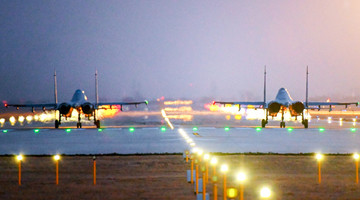By Guo Yuandan
Demonstrating national maritime strength is one of the connotations of a maritime parade. The changes of the main battleships in the past five maritime parades intuitively demonstrate the leap-forward development of the Chinese PLA Navy.
A military expert said to the Global Times on Apr. 12 that the changes show that the naval combat power system has been completely reshaped in the past decade.
In 1957, four ships of the North China Sea Fleet of the People's Liberation Army (PLA) Navy imported from the Soviet Union, including the guided-missile destroyers Anshan (Hull 101) (flagship), Fushun (Hull 102), Changchun (Hull 103) and Taiyuan (Hull 103), were the leading units of the first major naval parade in China. At that time, these four destroyers were the country’s main naval vessels with the largest tonnage and the strongest combat capability. They were the elite of the entire navy.
The Chinese Navy conducted a maritime combat drill in a certain area of the Yellow Sea on October 19, 1995, followed by a grand maritime parade. The military parade involved the largest number and types of naval vessels and aircraft since the founding of the People's Republic of China and the establishment of the PLA.
The flagship of this review was the guided-missile destroyer Harbin (Hull 112). The destroyer Harbin was the first generation of large-scale surface warships of the PLA Navy with ocean-going combat capabilities. Its appearance indicated that China had the will and ability to establish a maritime military force commensurate with the status and image of a great country.
In 2005, the Chinese and Russian navies held a grand maritime parade after the joint drill, to which the Chinese Navy's three major fleets sent their best troops.
The guided missile destroyer Hangzhou (Hull 136) was the first modern warship introduced from Russia in the late 1990s. The guided missile destroyer Guangzhou (Hull 168) was the first destroyer of China’s homegrown Type 052B. Military enthusiasts began to call the guided-missile destroyers Guangzhou (Hull 168), Wuhan (Hull 169), Lanzhou (Hull 170) and Haikou (Hull 171) the four new pillars of the PLA Navy.
The maritime parade in 2009 was the largest maritime parade in the history of the Chinese Navy and was attended by navy vessels from more than 30 countries and regions.
The guided missile destroyer Shijiazhuang (Hull 116) was the flagship of the 25 Chinese ships in the parade of 2009. The latest surface ships included the Type 054A frigate and the Type 052C guided missile destroyers. All the naval weapons and equipment were manufactured by China. The aircraft of the PLA Navy, including the Y-8 warning aircraft, Y-8 electronic reconnaissance aircraft, the JH-7 fighter jet, the J-8 fighter jet, anti-submarine helicopter formations and ambulance helicopter formations, all participated in the parade.
The fleet of the aircraft carrier Liaoning made a brilliant appearance at the maritime parade on April 12, 2018. A large number of new types of submarines, surface vessels and combat aircraft were on show.
Vessels commissioned after the 18th National Congress of the Communist Party of China (CPC) accounted for more than half of the total ships reviewed. The aircraft carrier, the Type 052D guided missile destroyer, the newest large-scale landing ship, and the ship-bore aircraft had their maiden appearance in the 2018 naval parade.
The warships of the parade consisted of vessels for strategic strike combat, underwater attack, open sea operations, aircraft carrier strikes, amphibious landings, offshore defense, and comprehensive security. The aircraft of the parade consisted of 10 air echelons including helicopters and aircraft for antisubmarine patrol operation, early warning and commanding, offshore operations, sea assault, remote support and cover and air-to-air operations.
An anonymous military expert told the Global Times on Apr. 12 that the maritime parade shows that the Navy’s combat power system has been completely reshaped in the past 10 years. The quality and effectiveness of naval construction has been significantly improved.
The expert added that progress has been made in informatization construction, the naval strategic capabilities have been rapidly advanced, and the modernization level of the naval equipment has a new look.
Disclaimer: The author is Guo Yuandan, reporter with the Global Times. The article is translated from Chinese into English by the China Military online. The information, ideas or opinions appearing in this article are those of the author from the Global Times and do not reflect the views of eng.chinamil.com.cn. Chinamil.com.cn does not assume any responsibility or liability for the same. If the article carries photographs or images, we do not vouch for their authenticity.









